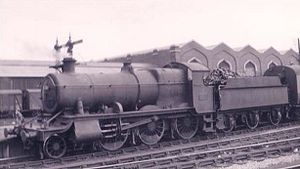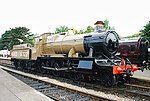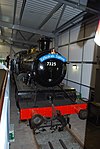GWR 4300 Class Contents Background Design Production series 8300 Class Use Withdrawal Accidents and incidents Preservation References External links Navigation menu"BRDatabase Complete BR Locomotive Database 1948-1997"815661Great Western archive pageRailuk database5322 Didcot page9303 SVR pagee
Great Western Railway locomotives2-6-0 locomotivesRobert Stephenson and Company locomotivesRailway locomotives introduced in 1911Railway Operating Division locomotivesStandard gauge steam locomotives of Great Britain
Great Western Railway2-6-0steam locomotivesG.J. Churchwardmixed traffic3100 Class2-6-2GWR 3150 Class4-4-0Saint’31XX’2-6-2Charles CollettSwindon Workstop feedpsiMPaWorld War IRailway Operating DivisionRobert Stephenson and CompanyBritish Railwaysbuffer beamflangepony truckBritish Railways'Aberdares'Grange ClassManor ClassSecond World WarBritish RailwaysChesterWoodham BrothersscrapyardBarry, South WalesDidcot Railway CentreGWR 5101 Class
| Great Western Railway 4300 Class | |||||||||||||||||||||||||||||||||||||||||||||||||||
|---|---|---|---|---|---|---|---|---|---|---|---|---|---|---|---|---|---|---|---|---|---|---|---|---|---|---|---|---|---|---|---|---|---|---|---|---|---|---|---|---|---|---|---|---|---|---|---|---|---|---|---|
 6381 at Southampton Terminus 1949 | |||||||||||||||||||||||||||||||||||||||||||||||||||
| |||||||||||||||||||||||||||||||||||||||||||||||||||
| |||||||||||||||||||||||||||||||||||||||||||||||||||
| |||||||||||||||||||||||||||||||||||||||||||||||||||
| |||||||||||||||||||||||||||||||||||||||||||||||||||
The Great Western Railway (GWR) 4300 Class is a class of 2-6-0 (mogul) steam locomotives, designed by G.J. Churchward for mixed traffic duties. Three hundred and forty two examples were built from 1911-1932.
Contents
1 Background
2 Design
3 Production series
3.1 Lot 183
3.2 Lots 193, 194 and 198
3.3 Lots 202 and 204-208
3.4 Lots 209, 211-212, 216, 230
3.5 Lots 218 and 222
3.6 Lot 276
4 8300 Class
5 Use
6 Withdrawal
7 Accidents and incidents
8 Preservation
9 References
10 External links
Background
In 1906 Churchward fitted a more powerful Standard No. 4 boiler to his successful 3100 Class 2-6-2T to create the GWR 3150 Class. These showed themselves to be successful locomotives but their 65 long tons 0 cwt (145,600 lb or 66 t) weight and 2,000 imp gal (9,100 l; 2,400 US gal) water capacity meant that they tended to be restricted to suburban passenger traffic. Churchward was looking forward to the replacement of various of his predecessor’s 4-4-0 classes on secondary duties. In 1911 he therefore designed a tender version of the 3150 class which would be suitable for a wide range of intermediate duties. [1]
Design
The class was ‘a total synthesis of standard parts, using the outside cylinders of the Saint, the wheels of ’31XX’ 2-6-2 tank and the No.4 boiler, in its superheated form.’[2] No prototype was required as the fundamental design had proved itself.
Production series
The locomotives quickly proved themselves to be so useful that they were produced more or less continuously in a series of batches (or lots) over a twelve year period (1911-1923), sometimes incorporating detailed differences. Two further lots were built in 1925 and 1932 by Churchward's successor, Charles Collett.[3]
Lot 183
The first twenty examples, numbered 4301-20, were delivered by Swindon Works between June and October 1911. These had inside steam pipes, and were among the first GWR locomotives to be fitted with top feed apparatus.[4] Nos. 4311–20 had boilers designed to operate at 225 psi (1.55 MPa) pressure but only 4315 and possibly 4316 ever worked at that pressure.[5]
Lots 193, 194 and 198
Three further batches, totalling a further forty locomotives (4321-4360) were built at Swindon and delivered June 1913 and May 1914, before the onset of the First World War impeded further production. These locomotives (and all subsequent examples had frames lengthened by 9 in (229 mm) at the rear to give better access for maintenance as well as providing more room in the cab.
Lots 202 and 204-208
The class proved to be ‘just the type that was needed during the 1914-18 war and were accordingly built in considerable numbers during that period.’[6] Six batches, totalling one hundred locomotives (numbered 4361-4399, 4300, 5300-5359) were built between May 1915 and September 1918, and a further ten (5360-5369) between January and June 1919. From 1917 detailed changes were made to the design giving better weight distribution between the wheels which were later applied to other members of the class[7]
Eleven examples of the class were transported to France during World War I in the service of the Railway Operating Division of the British Army and these were 5319 - 5326 and 5328 - 5330. One survives in preservation.
Lots 209, 211-212, 216, 230
The first three of these lots were for seventy locomotives built between June 1919 and July 1921 (Nos. 5370-99 and 6300-6341). Lot 216 was for a further 28 locomotives (6342-6369) but Swindon works was then unable to keep pace with the demand for them and only the first twenty were completed after delay, between March and December 1923. The remainder (6362-9 and 7320/1) were later built under lot 230 in 1925.[8]
6320 was converted to oil firing between 1947 and the equipment was removed in 1949.
Lots 218 and 222
As Swindon works could not keep pace an order was placed with Robert Stephenson and Company in 1921 for fifty locomotives (Nos. 6370-99 and 7300-7319). The first 35 of these (Lot 218) were built by the company between April 1921 and January 1922. The remaining fifteen were built at Swindon from parts manufactured by RSH between November 1921 and January 1922.
In 1925 Nos. 7300–7304 were modified for better balance and had detail alterations.
Lot 276
In 1932, Collett built a further twenty examples (9300 – 9319) to a modified design with side window cabs, outside steam pipes and a screw reverse. He also extended the frames, increasing the weight to 65 long tons 0 cwt (145,600 lb or 66 t) (72.8 short tons), which placed them in the Red band of route availability. After passing into British Railways ownership, these locomotives were modified back to light buffer beam design and were renumbered 7322–7341 between 1956 and 1959.
8300 Class

No. 5327 at Swindon 11 June 1950 (modified to the heavier version as No. 8327 1928-1944).
The class were widely used in Devon and Cornwall where the track had many sharp curves. It was found that flange wear on the leading driving wheels became excessive as a result of these bends. In November and December 1927 additional weight was added to the front end of four examples so that the pony truck would be forced to impart more side thrust to the main frames on bends. These locomotives reverted to their original state, but between January and March 1928, 65 engines of 5300 series received additional weight on the pony truck, and 3000 was added to their running numbers, temporarily creating an ‘8300 Class’. However, the additional weight placed them in the Red category of route availability. From 1944 onwards there was a shortage of locomotives in the Blue category and so the additional weights were removed and the surviving locomotives resumed their original running numbers. The last to be returned to its original condition was 8393 in September 1948.[9]
Use
The 4300 Moguls were the maids of all work on the GWR network and later the Western Region of British Railways. Employing a Standard number 4 boiler and the support struts similar to those fitted to the '2800' class, the class very quickly earned an excellent reputation in its ability to handle most types of traffic, from local stopping goods to main line expresses. According to O.S. Nock they "could handle the heavy goods work as well as the 'Aberdares' and could run up to 70 mph with passenger trains, in other words they were the ideal mixed traffic locomotive".[10]
Withdrawal

5322 preserved in WWI Railway Operating Division khaki livery
Although the class continued to be very useful and the final batch were still relatively new, 100 of the earlier examples were withdrawn between 1936 and 1939 and the wheels and motion of eighty were used for the Grange Class and twenty for Manor Class engines. It was intended to replace the whole class in this way but the advent of the Second World War in 1939 brought a temporary halt to withdrawals and the programme was never revived.[11]
Further withdrawals resumed in 1948 under British Railways ownership, but the last six examples survived until 1964.[12]
Accidents and incidents
- On 13 October 1928, locomotive No. 6381 was hauling a freight train that was run into by a passenger train at Charfield, Gloucestershire due to the driver of the passenger train overrunning signals. Sixteen people were killed and 41 were injured.[13]
- On 1 March 1937, a 4300 Class locomotive hauling a freight train that was in collision with a passenger train at Langley, Buckinghamshire. One person was killed and six were injured.[14]
- On 7 September 1945, locomotive No. 6315 was hauling a mail and freight train that was derailed near Sun Bank Halt, Denbighshire due to the trackbed being washed away following the failure of the bank of the Shropshire Union Canal. One person was killed and two were injured. The train's consist, except for a brake van, was destroyed in the ensuing fire.[15]
- In 1952, locomotive No. 7311 overran a signal and was derailed by trap points at Appleford, Oxfordshire.[16]
- On 6 September 1956, locomotive No. 9306 was hauling a parcels train that overran signals and ran into the rear of an express passenger train at Ludlow, Shropshire.[17]
Preservation
Only two examples have survived to preservation:
Note: Loco numbers in bold mean their current number.
| Number | Builder | Built | Withdrawn | Location | Current status | Image | Notes | |
|---|---|---|---|---|---|---|---|---|
| Original | Later | |||||||
5322 | 8322 | Swindon Works | Aug 1917 | Apr 1964 | Didcot Railway Centre | On static display |  | One of 11 locos exported to France in World War I. Painted in British Railways black with early crest. Withdrawn in Summer 2014 with boiler problems. |
| 9303 | 7325 | Swindon Works | Feb 1932 | Apr 1964 | Severn Valley Railway | In store |  | Moved from The Engine House to store in March 2019 |
5322 is the older of the two as it was built in 1917, during the Great War, at Swindon Works. It was sent, with several other members of the class, to France for hauling munitions and hospital trains. There it was painted in War Department livery and given the number ROD5322. Demobbed in 1919 at Chester it returned to the GWR fleet until it was withdrawn from service in April 1964. It was sent to Woodham Brothers scrapyard in Barry, South Wales. The first Barry locomotive to be subject to a preservation fund, it was the second locomotive to leave Woodham's: 5322 thus ended up as the sole early 43xx to be preserved. It was initially restored to working order, but was not steamed after 1975 until returning to steam in 2008 at the Didcot Railway Centre, restored to its 1919 War Department condition.
9303 is one of the final batch of 342 locomotives built between 1911 and 1932. They were built with larger cabs and had a weight attached to the buffer beam to place more weight on the leading pony wheels. This was done to reduce the wear on the leading driving wheels. In 1958 the weight was removed from the buffer beam to give the locomotive more route availability. At the same time it was renumbered 7325. The plan is to replace the missing weight at the next overhaul so it can run as 9303. 7325 has also run on the mainline in preservation.
An engine similar to the 4300 class was rebuilt from 5193 (a GWR 5101 Class 2-6-2T) to become a smaller boilered version of the class numbered 9351.
References
^ Nock, O. S. (1983). British Locomotives of the 20th Century Vol.1. London: Book Club Associates. p. 169..mw-parser-output cite.citationfont-style:inherit.mw-parser-output .citation qquotes:"""""""'""'".mw-parser-output .citation .cs1-lock-free abackground:url("//upload.wikimedia.org/wikipedia/commons/thumb/6/65/Lock-green.svg/9px-Lock-green.svg.png")no-repeat;background-position:right .1em center.mw-parser-output .citation .cs1-lock-limited a,.mw-parser-output .citation .cs1-lock-registration abackground:url("//upload.wikimedia.org/wikipedia/commons/thumb/d/d6/Lock-gray-alt-2.svg/9px-Lock-gray-alt-2.svg.png")no-repeat;background-position:right .1em center.mw-parser-output .citation .cs1-lock-subscription abackground:url("//upload.wikimedia.org/wikipedia/commons/thumb/a/aa/Lock-red-alt-2.svg/9px-Lock-red-alt-2.svg.png")no-repeat;background-position:right .1em center.mw-parser-output .cs1-subscription,.mw-parser-output .cs1-registrationcolor:#555.mw-parser-output .cs1-subscription span,.mw-parser-output .cs1-registration spanborder-bottom:1px dotted;cursor:help.mw-parser-output .cs1-ws-icon abackground:url("//upload.wikimedia.org/wikipedia/commons/thumb/4/4c/Wikisource-logo.svg/12px-Wikisource-logo.svg.png")no-repeat;background-position:right .1em center.mw-parser-output code.cs1-codecolor:inherit;background:inherit;border:inherit;padding:inherit.mw-parser-output .cs1-hidden-errordisplay:none;font-size:100%.mw-parser-output .cs1-visible-errorfont-size:100%.mw-parser-output .cs1-maintdisplay:none;color:#33aa33;margin-left:0.3em.mw-parser-output .cs1-subscription,.mw-parser-output .cs1-registration,.mw-parser-output .cs1-formatfont-size:95%.mw-parser-output .cs1-kern-left,.mw-parser-output .cs1-kern-wl-leftpadding-left:0.2em.mw-parser-output .cs1-kern-right,.mw-parser-output .cs1-kern-wl-rightpadding-right:0.2em
^ Nock (1983 p.169
^ Production details from Le Fleming, H.M. (1962). The Locomotives of the Great Western Railway, part nine: Standard two-cylinder Classes. Kenilworth: RCTS. pp. J24–5. ISBN 0901115371.
^ Le Fleming (1962), pp. J5 and J13.
^ Le Fleming (1962), pp. J5 and J13.
^ Le Fleming (1962), p. J13.
^ Le Fleming (1962), p. J13.
^ Le Fleming (1962), p. J13.
^ Le Fleming (1962), p. J14.
^ Nock (1983 p.169
^ Le Fleming (1962), p. J14.
^ "BRDatabase Complete BR Locomotive Database 1948-1997". brdatabase.info.
^ Gerard, Malcolm; Hamilton, J. A. B. (1981) [1967]. Trains to Nowhere. London: George Allen & Unwin. pp. 45–49. ISBN 0-04-385084-7.
^ Trevena, Arthur (1980). Trains in Trouble. Vol. 1. Redruth: Atlantic Books. p. 40. ISBN 0-906899-01-X.
^ Vaughan, Adrian (1989). Obstruction Danger. Wellingborough: Patrick Stephens Limited. pp. 80–88. ISBN 1-85260-055-1.
^ Earnshaw, Alan (1993). Trains in Trouble: Vol. 8. Penryn: Atlantic Books. p. 25. ISBN 0-906899-52-4.
^ Hall, Stanley (1990). The Railway Detectives. London: Ian Allan. p. 119. ISBN 0 7110 1929 0.
- Sources
Whitehurst, Brian (1973). Great Western Engines, Names, Numbers, Types and Classes (1940 to Preservation). Oxford, UK: Oxford Publishing Company. pp. 39, 48–49, 56–57, 66, 98, 103, 133–134. ISBN 978-0-9028-8821-0. OCLC 815661.
External links
| Wikimedia Commons has media related to GWR 4300 Class. |
- Great Western archive page
- Railuk database
- 5322 Didcot page
- 9303 SVR page
2-6-0 locomotives, Great Western Railway locomotives, Railway locomotives introduced in 1911, Railway Operating Division locomotives, Robert Stephenson and Company locomotives, Standard gauge steam locomotives of Great BritainUncategorized